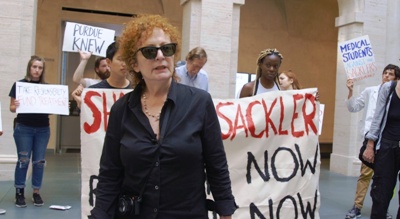
 The story of the radical art photographer Nan Goldin, and how she led a movement against the Sackler family, the billionaires who pushed OxyContin.
The story of the radical art photographer Nan Goldin, and how she led a movement against the Sackler family, the billionaires who pushed OxyContin.
All the Beauty and the Bloodshed. That’s the title of the new movie by Oscar-winning documentary filmmaker Laura Poitras. It starts with a basic framing story, a story of activism. We see Nan Goldin, one of the more famous American art photographers, spearheading a campaign against the Sacklers, a billionaire family that owns Purdue Pharma. Beginning in the 1990s, Purdue heavily promoted OxyContin, and other opioids, as a safe and non-addictive medication for serious pain. Hundreds of thousands of people did become addicted, and Goldin was one of them. There were many thousands of deaths from overdose. Goldin was lucky not to have succumbed, although she came close. The organization she founded is called PAIN, Prescription Addiction Intervention Now. They advocate for state-funded treatment and for a social policy of harm reduction.
One of Goldin’s central goals was to make the Sackler family pay for the damage it did. And her prominence in the art world gave her a point of attack. The Sacklers have their names on many rooms, departments, and exhibits in art museums around the world, having given millions of dollars to these institutions and donated many priceless artworks as well. This, of course, makes them respectable in the eyes of the establishment, the rich upper class that uses philanthropy as PR. As the film opens, we see Goldin’s group enacting a demonstration and a die-in at the Met in New York, with people lying on their backs as if dead, surrounded by prescription bottles for OxyContin. The goal is to make the museums stop taking Sackler money, and after that make them take the Sackler family’s names off the walls and doors and plaques in all the museums.
A normal documentary would give us this story alone, and make that the point. But although this framing device stays with us from the beginning of the film to the end, and is important, Poitras is also interested in Nan Goldin herself. Gradually, through Goldin’s own words, and that of other friends and witnesses, we learn her life story. She grew up in the Boston area, in a suffocating family with parents desperate to be like everyone else. Her older sister Barbara rebelled, and was sent to an institution, eventually dying of suicide at 18.
Barbara’s story became a central inspiration for Nan, who ran away, got kicked out of schools, and was actually sent to a foster family as if she were an orphan. Breaking free in her 20s, she entered the Boston gay subculture, drag queens and transgender people her best friends. Her informal, self-taught photography of this group got attention in the art world. Eventually she moved to New York, and the film becomes a document not only of her life, but of the many amazing friends and colleagues in the New York art world and gay community. Her slide shows were major events affirming that this community exists and has a right to. It was a life on the margins, poor in money terms, but rich in love. There was a lot of pain as well, the confronting of past abuse, the drama of what she called “sexual dependency,” and then came the tragedy of AIDS and the unspeakable toll it took. But it’s the sense of great, overpowering love within a community that more than anything we take away from this film.
All the Beauty and the Bloodshed: this stark title is from something Goldin’s older sister wrote before taking her life. The film celebrates both aspects with passion. Watching it for me was to recognize at a deeper level what is truly important in life.

